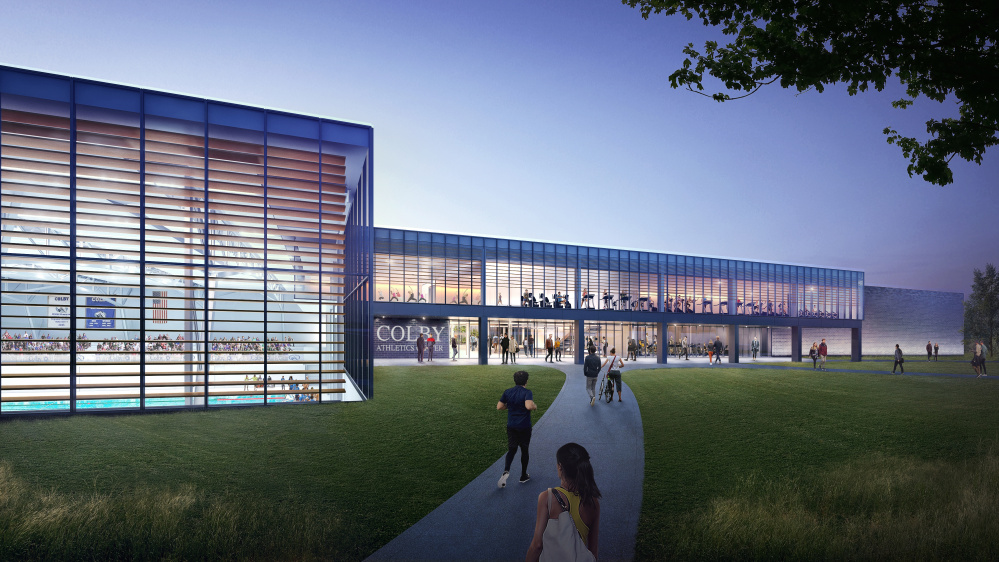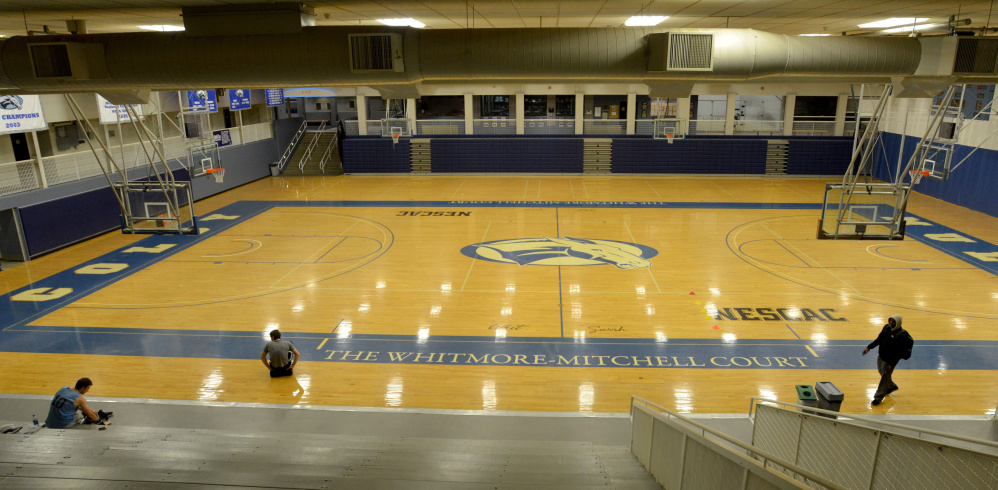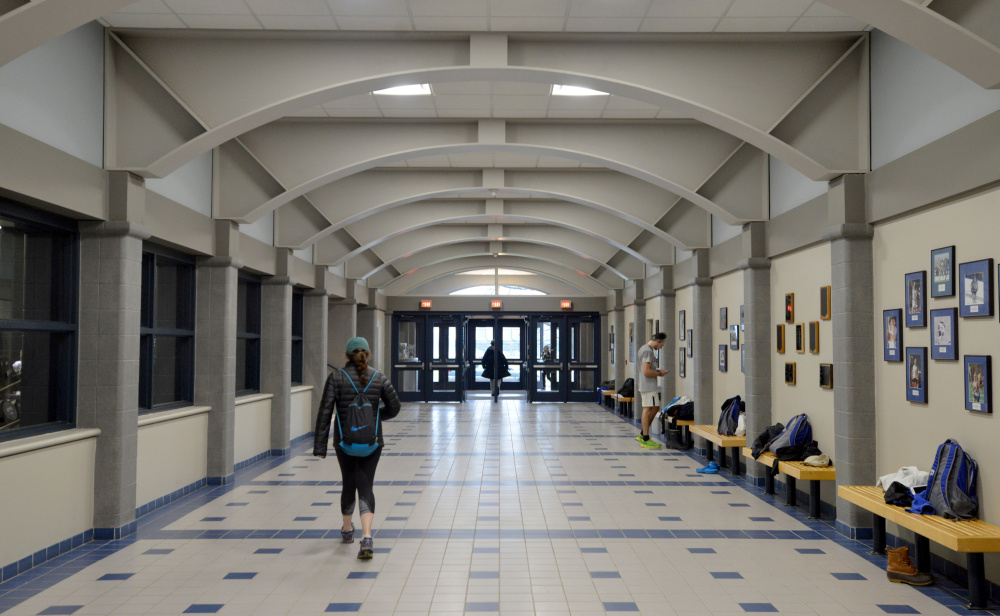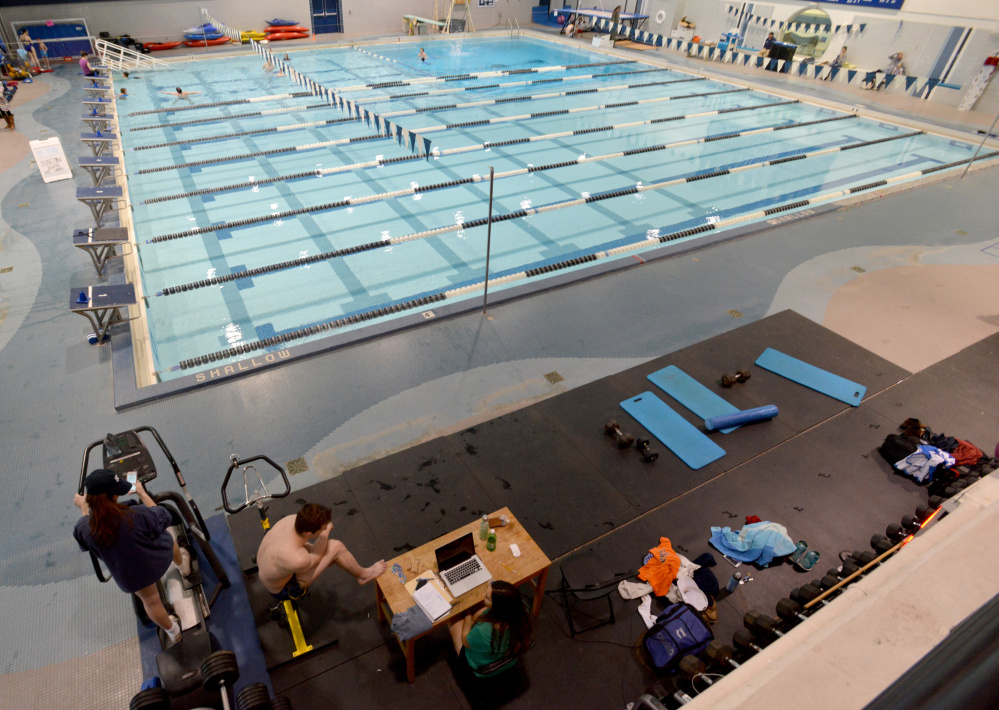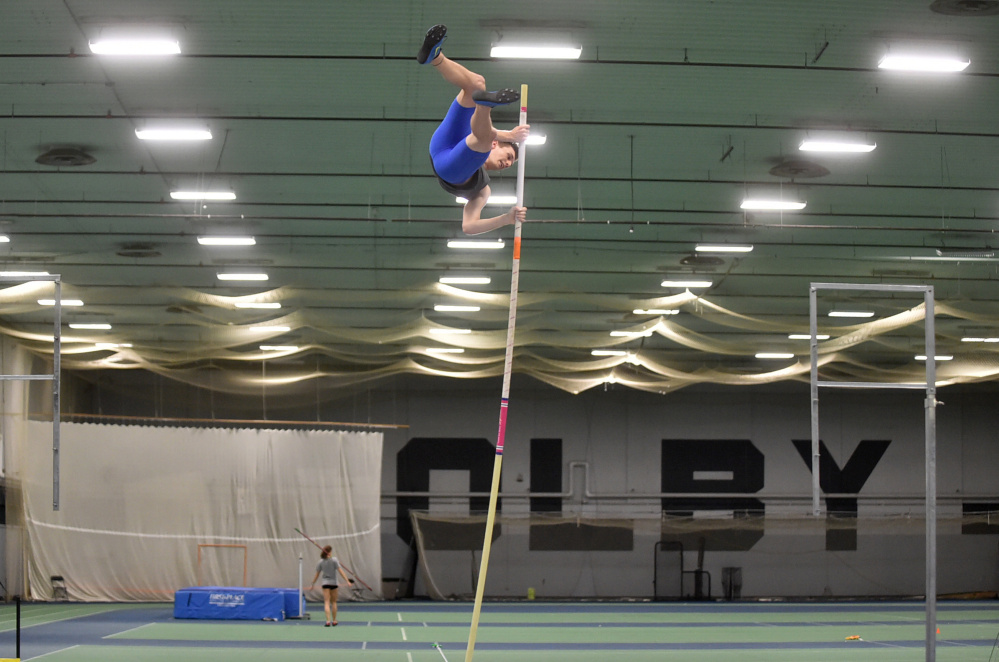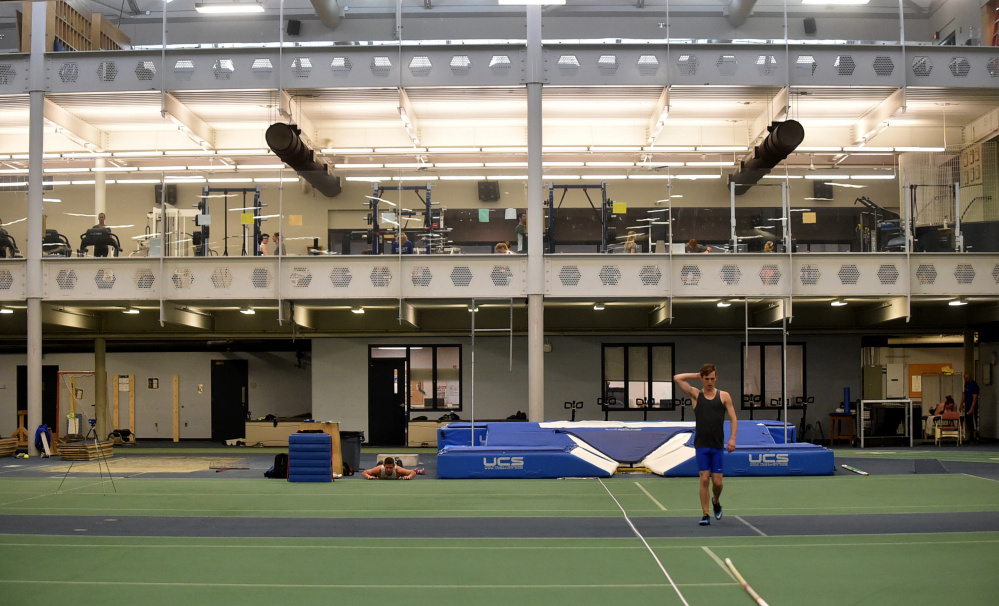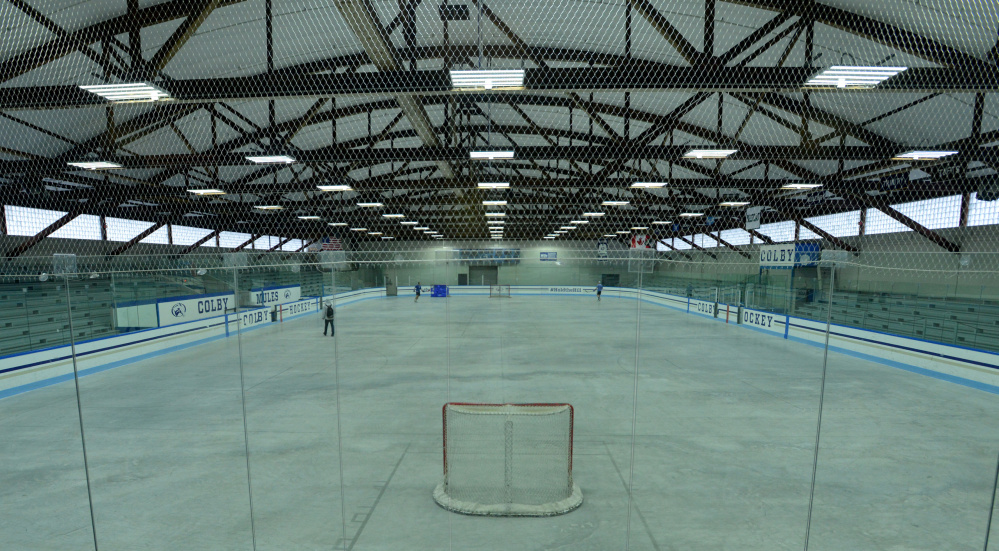WATERVILLE — Colby College announced Wednesday that it will build a $200 million state-of-the-art athletic center on campus that is believed to be the largest in the New England Small College Athletic Conference and have the first Olympic-sized swimming pool in the state.
The facility, which would be the largest construction project at Colby and is expected to be ready for occupancy in 2020, will include an indoor competition center with a 200-meter track and a multi-level, 13,500-square-foot fitness center. The center will be available for use by the community, region and state and will be among the best Division III facilities in the country, according to officials.
Colby President David Greene said Wednesday night that preparatory work will start on the center this summer and fall with the idea that construction will follow.
“It will take us three years, essentially, because it is 350,000 square foot, and we’ll open in the summer of 2020,” Greene said.
The building of the center represents the largest single project in the college’s history and is expected to create an economic boon to the city, bringing in more than $1 million in revenue a year to the area from people staying in hotels and eating and spending money on other activities, according to Greene.
He said that from the very beginning of the planning process for the athletic center, officials thought about how to create a facility that would help the community overall. The aquatic center, for instance, will be a great destination in northern New England for swimming groups from across the state, he said.
Colby also is investing more than $45 million in downtown revitalization efforts that include building a student residential complex and boutique hotel and renovating an historic building, all on Main Street.
“What we thought about from the beginning as we talked about the downtown revitalization piece is that two things that would really help stimulate economic development are arts and athletics,” Greene said. “Given all of the great facilities, such as those at Thomas College and the Alfond Youth Center, our ability to host major tournaments, camps and conference championships dramatically changes with these kinds of athletic facilities.”
The current Harold Alfond Athletic Center on Campus Drive will be demolished after the new facility is complete.
The decision to build a new athletic center was driven by three things, according to Greene. He said that more than a third of students come to Colby as athletes and play on intercollegiate varsity teams, and providing them with championship-caliber venues is important to Colby. The venues Colby has are no longer appropriate for competition because they were built so long ago, according to Greene. For instance, the college has a 220-yard indoor track, but now people race on 200-meter tracks, he said.
Many of the structural and mechanical systems at the current athletic center have outlived themselves, and to keep the building going would require an extraordinary investment, Greene said.
“We decided if we could raise the money, we’d build a new athletic facility. We’ve already raised $100 million for this project. We’re active and engaged. Knowing we already have $100 million in commitments gives us confidence we can move ahead with this project.”
The new center, to include a gymnasium, squash and aquatic centers, a hockey arena, studios, training rooms and coaching suites, will be built to the west of the current center, across Campus Drive from Johnson Pond, where an athletic field now is located. It will feature the first 50-meter swimming pool in the state and an open-air atrium allowing for outdoor light throughout the facility. Colby officials say the center will serve as a resource for the entire campus, as well as athletes from Waterville, the state and New England.
Mayor Nick Isgro on Wednesday said he is thrilled about plans for the new athletic center, and everyone else should be also.
“I think this is an incredibly exciting project because when we look at any time we have an event held in or around Waterville, our local businesses see an influx of revenues, particularly meals and lodging. This puts Waterville in a unique position in the New England area to host competitions unlike a size that we’ve seen at this point.”
Kimberly Lindlof, president and chief executive officer of the Mid-Maine Chamber of Commerce and executive director of the Central Maine Growth Council, also is excited about Colby’s plans. Lindlof said Colby’s intentions and plans for downtown revitalization and other projects on campus really are moving the needle for Waterville. The new athletic center will bring people to Waterville for swim meets and other competitions in the colder months, when business for restaurants and hotels is slower, she said.
“This is going to have a really great impact on those businesses in particular and hopefully on retail as well,” Lindlof said. She also noted that the new facilities will be much more accommodating for those watching athletic events.
PAVING THE WAY
Excavation started last year to move Colby competition fields to create space for the new athletic complex. Those three new competition and recreational fields include a practice field, a competition soccer field and Bill Alfond Field, which will continue to be used for competition field hockey and lacrosse. The new fields are behind the current athletic center and will be playable in the fall.
Colby also built and opened last year a new lighted, turf baseball-softball complex off Mayflower Hill Drive east of the current athletic center that will continue to be available for the community and local school teams.
“Colby’s athletic facilities have a long tradition of serving as a home for local and regional teams and community users,” Brian Clark, Colby’s vice president of planning, said in a Colby news release. “The new athletics complex will expand on this commitment and, along with outstanding facilities such as the nearby Quarry Road and the Kennebec Messalonskee Trails, will help to make Waterville a true destination for athletics.”
Because the new center will be state-of-the-art and up to specific standards for competition, there will be more opportunities for the community and state as a whole to use it, according to Colby officials. Colby Communications Director Kate Carlisle said the new pool will be the only Myrtha pool in New England and has precision technology used in pools for international competition.
“We’re envisioning swim meets being at Colby all the time because of the availability of these facilities,” Carlisle said.
Colby will continue to welcome everyone to Waterville who currently use the college’s facilities, she said.
The new center will reflect environmentally sound design for the site and building and will include a compact footprint, renewable energy systems, ecosystem-sensitive landscape with native plantings and wetland conservation, according to the Colby news release.
Greene said in the release that Colby has had a long tradition of excellence dating back to the 1950s and ’60s with construction of what eventually would become the Alfond Athletic Center on campus.
“Six decades later, we have re-imagined how we can support the Colby and broader communities with an exceptional new competition and recreational facility,” he said.
Many high school and youth hockey teams use Colby’s ice for practice and competition. This year more than a dozen local teams used the new baseball-softball complex for early games, and the basketball court also is used by community organizations, according to Carlisle. Local sports camps also use facilities during the summer.
Colby enrolls 2,000 students from more than 80 countries. More than 80 percent take part in organized athletics and about a third are varsity athletes.
The New England Small College Athletic Conference includes Colby, Bates, Bowdoin, Middlebury, Hamilton, Trinity, Williams, Amherst and Connecticut colleges, as well as Wesleyan and Tufts universities.
Contacted by phone Wednesday afternoon, an official at NESCAC said no one was available to comment on Colby’s planned athletic center and confirm whether it will be larger than any in the 11-college conference. A Facebook message sent Wednesday to Lisa Champagne, NESCAC’s assistant director for media relations, was not returned.
Much has been written about colleges’ and universities’ focus on creating state-of-the art athletic centers and how they are funded.
A Washington Post story from Dec. 21, 2015, written by Will Hobson and Steven Rich, likens institutions’ building of new athletic centers to an “athletic facilities arms race” in which big public universities spend hundreds of millions of dollars, and that spending is “one of the biggest reasons otherwise profitable or self-sufficient athletic departments run deficits.”
The story is based on information from athletic department financial records from 48 schools in the five wealthiest conferences in college sports.
“In 2014, these 48 schools spent $772 million combined on athletic facilities, an 89 percent increase from $408 million spent in 2004, adjusted for inflation,” the story says. “Those figures include annual debt payments, capital expenses and maintenance costs. Big-time college athletic departments are taking in more money than ever — and spending it just as fast.”
A Nov. 15, 2015, story in the Chronicle of Higher Education, written by Brad Wolverton, Ben Hallman, Shane Shifflett and Sandhya Kambhampati, details information The Chronicle and Huffington Post gathered from 234 public universities that compete in Division I conferences, with the information focusing on the years 2010-2014. They presented an analysis about subsidies, or how much universities donate or invest in athletic departments to make up for a lack of earned revenue. Subsidies can come from three sources — student fees, funds allocated by the school, and government support, according to the piece, which says earned revenue includes income generated through ticket sales, endowments, royalties, and TV and conference distributions.
The analysis did not include information about private institutions such as Colby, noting that private institutions are not subject to public record laws.
Amy Calder — 861-9247
Twitter: @AmyCalder17
Send questions/comments to the editors.


